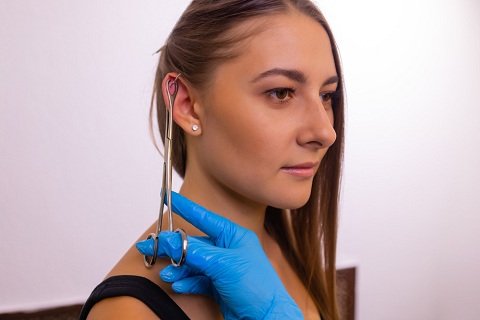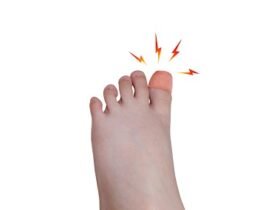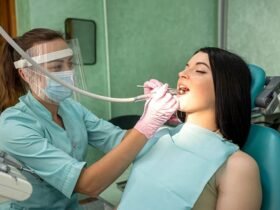A helix piercing, which typically takes about six to nine months to heal, is a popular choice for those looking to add a unique touch to their ear jewelry collection. This healing period can vary based on several factors, including aftercare practices, individual healing rates, and lifestyle habits.
What is a Helix Piercing?
A helix piercing is located in the upper cartilage of the ear and offers a versatile option for those interested in multiple jewelry styles.
At the end of this article, we will discuss in detail the various factors that influence the healing process and the essential aftercare tips to ensure a smooth and successful healing journey.
Different Types of Helix Piercing
Helix piercings are a popular type of ear piercing that involves the upper cartilage of the ear. Here are the different types of helix piercings:
- Standard Helix Piercing: A single piercing on the outer upper cartilage of the ear.
- Forward Helix Piercing: Located on the outer upper cartilage, near the face.
- Double Helix Piercing: Two piercings placed vertically or diagonally in the upper cartilage.
- Triple Helix Piercing: Three piercings placed vertically or in a triangular formation in the upper cartilage.
- Industrial Piercing: Two helix piercings connected by a single piece of jewelry, usually a barbell.
- Orbital Helix Piercing: Two holes connected by one piece of jewelry, typically a ring.
- Snug Piercing: Located in the inner cartilage, parallel to the outer rim but closer to the ear canal.
- Rook Piercing: A piercing through the cartilage fold above the tragus.
- Auricle Piercing: Placed on the middle cartilage, between the lobe and the helix.
Why Helix Piercing?

- Unique and Stylish: Offers a distinctive look compared to traditional earlobe piercings.
- Versatile Jewelry Options: Accommodates a wide variety of jewelry styles, including hoops, studs, and multiple piercings.
- Sturdy Location: The cartilage in the helix area provides a strong, stable location for piercings, reducing the risk of stretching or sagging.
- Customization: Allows for creative combinations and multiple piercings for a personalized style.
- Trendy Appeal: Popular among fashion enthusiasts and those looking to make a statement with their ear adornments.
At the end of this article, we will discuss in detail the factors that influence the healing process and essential aftercare tips to ensure a smooth and successful experience with your helix piercing.
Healing Process of Helix Piercing
The healing process for a helix piercing involves several stages and requires proper care to ensure successful healing.
- Timeline: Generally, helix piercings take 3-6 months to heal, but it can vary based on individual healing rates and aftercare.
- Initial Healing Phase: The first few weeks involve swelling, redness, and tenderness.
- Ongoing Care: Regular cleaning with saline solution is essential to prevent infection.
- Signs of Healing: Gradual reduction in swelling, redness, and tenderness; the piercing becomes less sensitive.
- Potential Complications: Be alert for signs of infection such as excessive redness, swelling, and discharge; consult a professional if these occur.
- Jewelry Care: Avoid changing jewelry too early; wait until the piercing is fully healed to minimize irritation.
- Avoidance: Refrain from touching the piercing with dirty hands and avoid sleeping on the pierced side to prevent irritation.
Precautions for Helix Piercing
Precautions for a helix piercing are essential to ensure proper healing and avoid complications.
- Choose a Professional Piercer: Ensure your piercing is done by a certified and experienced professional to minimize risks.
- Sterile Environment: Verify that the piercing studio uses sterilized equipment and maintains a clean environment.
- Appropriate Jewelry: Select high-quality, hypoallergenic jewelry to reduce the risk of allergic reactions and infections.
- Follow Aftercare Instructions: Adhere strictly to the aftercare guidelines provided by your piercer, including cleaning routines and handling tips.
- Avoid Touching: Refrain from touching or twisting the piercing with unwashed hands to prevent introducing bacteria.
- Avoid Sleeping on Piercing: Sleep on the opposite side to avoid pressure and irritation on the new piercing.
- Keep Hair and Products Away: Ensure hair, hair products, and other potential irritants do not come into contact with the piercing.
- Monitor for Signs of Infection: Watch for symptoms such as excessive redness, swelling, or discharge, and seek medical advice if these occur.
Treatments for Helix Piercing
Treatments for a helix piercing focus on ensuring proper healing and addressing any complications that may arise.
- Saline Solution Cleaning: Clean the piercing twice daily with a saline solution to prevent infection and promote healing.
- Avoiding Irritation: Refrain from touching or twisting the jewelry, and avoid sleeping on the pierced side.
- Managing Swelling: Apply a cold compress or take anti-inflammatory medication to reduce swelling and discomfort.
- Infection Treatment: If signs of infection appear (redness, swelling, discharge), use an antiseptic solution and consult a healthcare professional for further treatment, which may include antibiotics.
- Removing Jewelry: In cases of severe infection or allergic reaction, a professional may recommend temporarily removing the jewelry.
- Hydrocortisone Cream: For minor irritations or bumps, applying a small amount of hydrocortisone cream can help reduce inflammation.
- Consultation for Complications: Always seek professional advice if experiencing unusual pain, prolonged swelling, or signs of allergic reactions.
Potential Complications for Helix Piercing
If complications arise with a helix piercing, several issues can occur that require attention and care.
- Infection: Symptoms include redness, swelling, pain, and discharge. Severe infections may require antibiotics and medical intervention.
- Allergic Reaction: Redness, itching, and rash around the piercing site; switching to hypoallergenic jewelry is necessary.
- Keloids: Raised, scar-like tissue forming around the piercing; treatment may involve silicone sheets, corticosteroid injections, or surgical removal.
- Migration/Rejection: The body pushes the jewelry out, causing the piercing to move or close; removing the jewelry and allowing the site to heal is often required.
- Cartilage Damage: Improper piercing techniques can cause damage to the cartilage, leading to deformation or chronic pain; professional assessment and treatment are essential.
- Pain and Swelling: Persistent discomfort and swelling might indicate an underlying issue such as infection or improper aftercare; seek professional advice for appropriate treatment.
- Embedded Jewelry: Jewelry becoming stuck or embedded in the skin due to swelling or improper placement; may need surgical removal by a healthcare professional.
Aftercare and Maintenance for Helix Piercing
Aftercare and maintenance are crucial for the proper healing of a helix piercing and preventing complications.
- Clean Regularly: Clean the piercing twice daily with a saline solution to prevent infection and promote healing.
- Avoid Touching: Refrain from touching or twisting the piercing with unwashed hands to prevent introducing bacteria.
- Avoid Sleeping on Piercing: Sleep on the opposite side to avoid pressure and irritation on the new piercing.
- Keep Hair and Products Away: Ensure hair, hair products, and other potential irritants do not come into contact with the piercing.
- Monitor for Infection: Watch for symptoms such as excessive redness, swelling, or discharge, and seek medical advice if these occur.
- Avoid Submersion in Water: Refrain from swimming in pools, hot tubs, and natural bodies of water to prevent exposure to bacteria.
- Avoid Changing Jewelry Early: Wait until the piercing is fully healed before changing jewelry to minimize irritation and infection risk.
- Maintain a Healthy Lifestyle: Support the healing process by maintaining a balanced diet, staying hydrated, and avoiding smoking and excessive alcohol consumption.
How long does a helix piercing take to heal?
A helix piercing typically takes about three to six months to heal fully. However, the exact healing time can vary depending on several factors, including:
General Timeline:
- Healing typically takes 3 to 6 months, but individual experiences may vary.
Factors Affecting Healing Time:
- Individual Healing Rate: Healing time can vary based on factors such as age, overall health, and immune system function.
- Aftercare Compliance: Following proper aftercare instructions diligently can promote faster healing.
- Placement: Piercings closer to the head may take longer to heal due to reduced airflow and increased pressure.
Stages of Healing:
- Initial Stage (0-4 weeks): Swelling, redness, and tenderness are common during this period.
- Intermediate Stage (4-8 weeks): Swelling begins to decrease, and the piercing site may feel less sensitive.
- Final Stage (8-12 weeks and beyond): The piercing site continues to strengthen, and any remaining discomfort gradually subsides.
Signs of Healing:
- Reduced Swelling: Swelling gradually decreases over time as the piercing heals.
- Decreased Sensitivity: The piercing site becomes less tender to touch.
- Formation of a Fistula: A fistula, or channel of scar tissue, forms around the piercing, indicating healing progress.
Warning Signs:
- Prolonged Swelling: Swelling that persists beyond the initial healing stages may indicate an issue.
- Excessive Redness or Discharge: These symptoms may signal infection and should be addressed promptly.
- Persistent Pain: Lingering pain or discomfort could indicate an underlying problem and requires professional evaluation.
Post-Healing Care:
- Even after the initial healing period, it’s essential to continue practicing good hygiene and avoiding activities that may irritate the piercing.
- Regularly clean the piercing site with saline solution and avoid changing jewelry prematurely to prevent complications.
Consultation:
- If you have concerns about the healing process or experience any unusual symptoms, consult with a professional piercer or healthcare provider for guidance.
FAQs About How Long Does a Helix Piercing Take to Heal
Here are some frequently asked questions regarding the healing time of a helix piercing:
- How long does it take for a helix piercing to heal?Healing typically takes 3 to 6 months, but individual experiences may vary based on factors such as aftercare compliance, placement, and individual healing rates.
- What factors can affect the healing time of a helix piercing?Factors such as age, overall health, immune system function, aftercare compliance, and the placement of the piercing can all influence healing time.
- What are the stages of healing for a helix piercing?Healing progresses through stages, including an initial stage (0-4 weeks) characterized by swelling and tenderness, an intermediate stage (4-8 weeks) with reduced swelling, and a final stage (8-12 weeks and beyond) where the piercing site strengthens.
- How can I tell if my helix piercing is healing properly?Signs of proper healing include reduced swelling, decreased sensitivity, and the formation of a fistula, or scar tissue channel, around the piercing.
- What should I do if my helix piercing doesn’t seem to be healing?If you experience prolonged swelling, excessive redness or discharge, persistent pain, or any other unusual symptoms, it’s important to consult with a professional piercer or healthcare provider for guidance and evaluation.
Conclusion:
The healing time for a helix piercing typically spans between 3 to 6 months, with individual experiences varying based on factors such as aftercare compliance, placement, and individual healing rates. Throughout the healing process, it’s important to remain vigilant for signs of progress, such as reduced swelling and sensitivity, while also being aware of warning signs such as prolonged swelling or persistent pain that may indicate complications. Post-healing care is crucial to maintain the health of the piercing site, including regular cleaning with saline solution and avoiding activities that may irritate the piercing. Consulting with a professional piercer or healthcare provider is advisable if any concerns or unusual symptoms arise during the healing period.











Got a Questions?
Find us on Socials or Contact us and we’ll get back to you as soon as possible.